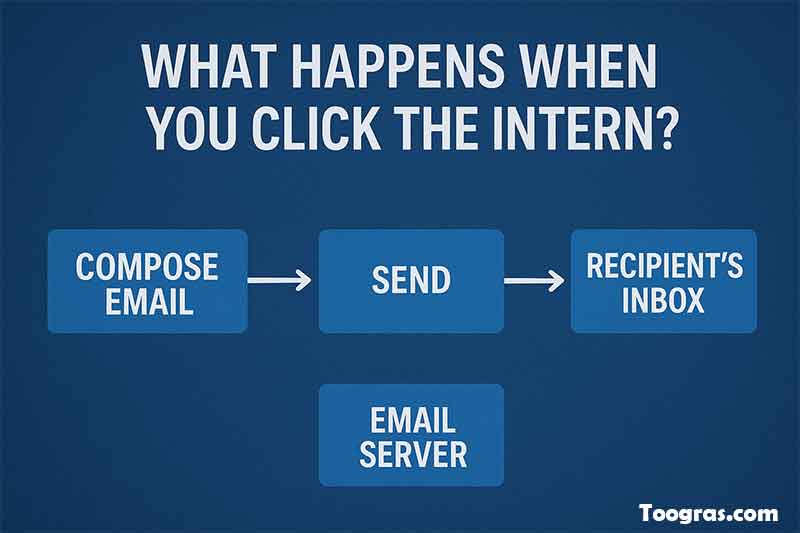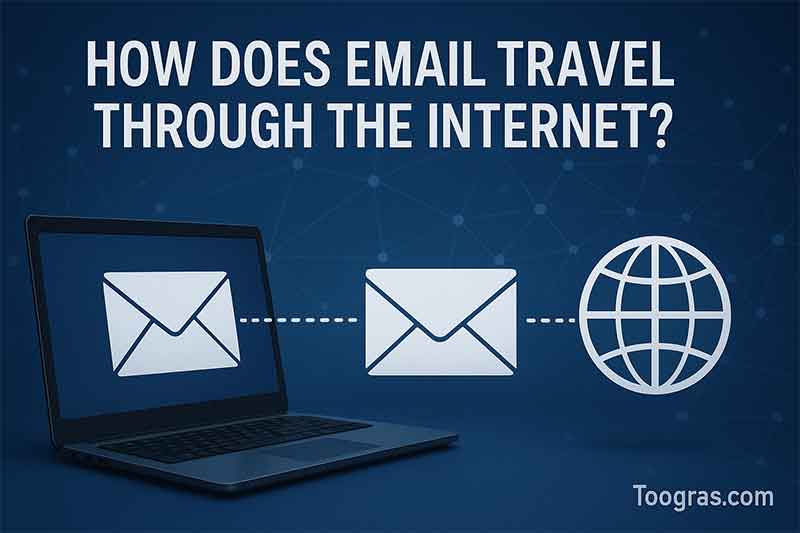How Does Email Travel Through the Internet?
Email is something we use every day, but have you ever wondered how does email travel through the internet? Behind that simple “send” button lies a complex but fascinating process. Understanding the email process explained helps you see how communication over internet works in real time. Let’s break it down step by step in a simple way.
What Happens When You Click “Send”?
When you write an email and hit send, your email program (like Gmail, Outlook, or Apple Mail) doesn’t directly connect to your recipient’s inbox. Instead, it goes through multiple steps and systems. Think of it like mailing a letter—you drop it off, it gets sorted, routed, and finally delivered. The internet follows a similar pattern.
Step 1: Composing the Email
You start with an email client (app or web-based service). The message contains text, attachments, sender info, recipient address, and a timestamp. This is the “package” ready to be sent.
Step 2: Handing Over to SMTP Server
SMTP (Simple Mail Transfer Protocol) is the standard for sending emails. Your client hands the email to your SMTP server, which works like a local post office. This server checks if the email is valid and prepares it for delivery.
Step 3: DNS Lookup – Finding the Recipient’s Server
The email needs to know where to go. This is where DNS (Domain Name System) comes in. Just like phonebooks match names to numbers, DNS matches the recipient’s domain (like yahoo.com) to its mail server IP address. Without DNS, your email would have nowhere to travel.
Step 4: Email Routing
Now the SMTP server routes the message to the recipient’s mail exchange server (MX server). This is like passing mail between regional post offices. This part is key in email routing simple explanation.
Step 5: Receiving by POP3/IMAP Server
Once the email arrives at the recipient’s server, it waits in a mailbox. The recipient’s device uses POP3 or IMAP to download or sync the email. IMAP keeps copies across devices, while POP3 usually downloads and removes it from the server.
Step 6: Delivery to Inbox
Finally, the recipient opens their email client, and the message appears in the inbox—completing the step by step email travel.

What Protocols Make Email Work?
Email depends on a few core protocols:
- SMTP – Sending emails.
- IMAP – Syncing across devices.
- POP3 – Downloading emails to one device.
- MIME – Formatting emails, especially with attachments.
These protocols ensure smooth communication over internet for email.
What Happens If Something Goes Wrong?
Sometimes emails get delayed, bounce back, or land in spam. This happens if:
- The recipient’s server is offline.
- The DNS record can’t be found.
- The sender’s server is flagged as spammy.
- Attachments are too large.
In such cases, the SMTP server may retry sending, or return a “failed delivery” message.
Example: Sending an Email from Gmail to Yahoo
- You type an email in Gmail and hit send.
- Gmail’s SMTP server takes over.
- DNS checks Yahoo’s MX records.
- The email routes through the internet to Yahoo’s mail server.
- Yahoo stores the email in your friend’s inbox.
- Your friend’s Yahoo client fetches it with IMAP.
It all happens in seconds, but dozens of systems work together in the background.
How Does Email Travel Through the Internet Securely?
Security is a major concern. Emails pass through multiple servers, so encryption is crucial:
- TLS (Transport Layer Security): Encrypts emails in transit.
- SPF, DKIM, DMARC: Help verify if the email is really from the sender’s domain and not a spammer.
This ensures safer communication over internet.
How Does the Internet Actually Send the Email?
Emails don’t move as whole messages across one line. Instead, the data is broken into packets, labeled with sender and destination addresses, then routed across the internet through multiple servers and routers. Once they arrive, the packets are reassembled into your email.
It’s similar to how logistics companies break down large shipments into smaller loads before reaching the destination.
Why Understanding Email Routing Matters
Knowing how emails move through the internet helps businesses and individuals:
- Troubleshoot delivery issues.
- Improve cybersecurity.
- Understand privacy risks.
- Optimize communication systems.
Just like knowing how solar panels work for home use (source), learning how email travels helps you appreciate everyday technology.
Fun Fact: Emails Are Like Digital Letters
If you compare email with old-fashioned mail:
- SMTP = Local post office
- DNS = Address lookup
- MX Server = Regional post office
- POP3/IMAP = Mailbox delivery
This simple analogy makes the email process explained much easier.
Related Questions
Usually, it’s less than a second. However, delays can happen if servers are overloaded or if there are routing issues. This is why sometimes your email appears instantly, and other times it feels like it’s stuck.
Yes. Emails often contain headers showing routing information. Businesses use tracking pixels for marketing emails, though privacy tools are improving to block these.
Emails are routed through multiple servers and stored until retrieved, while instant messages often use direct server connections with less delay. Still, both rely on communication over internet protocols.
Final Thoughts
So, how does email travel through the internet? In short, your email takes a multi-step journey: from your device to an SMTP server, through DNS lookup, routed across servers, stored in a mailbox, and finally delivered to the recipient’s inbox.
It’s a blend of protocols, routing systems, and security checks that make global digital communication possible in seconds. Next time you hit “send,” you’ll know the fascinating step by step email travel happening behind the scenes.
If you enjoyed learning how the internet works, you might also like exploring how a septic tank works (read here)—another system that seems invisible but is crucial in daily life.







